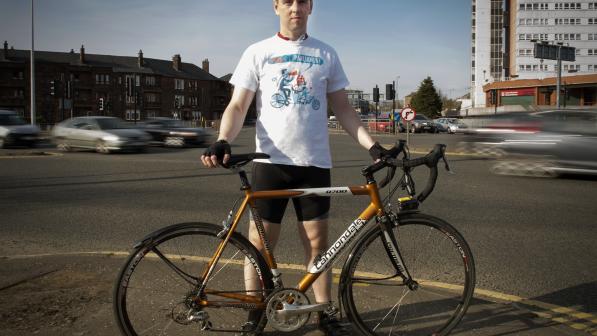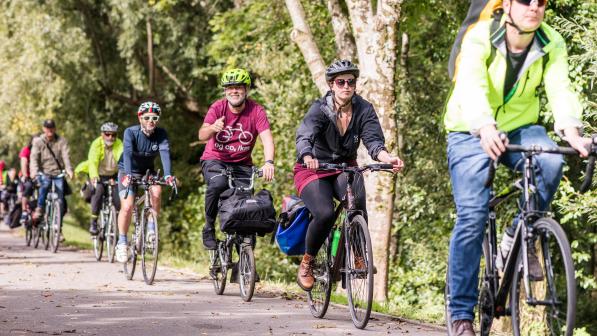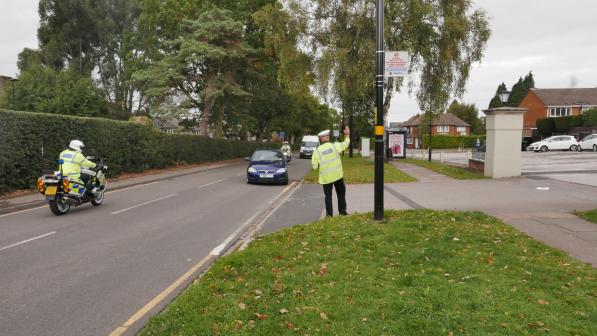Why membership matters for Cycling UK’s campaigning

I’ve been working for Cycling UK for nearly five years and in that time, I’ve never heard a member say that they don’t want us to campaign.
When I’m contacted by members, it’s usually to ask whether we can do more campaigning or lobbying on a specific issue, or support a campaign in their local area. That often sparks a conversation with my team about priorities - what becomes a public facing-campaign, what we lobby for, and how we influence change from behind-the-scenes.
Part of our DNA
But nobody asks us not to do this work and, every time we consult our members, the results support our own observations: members expect us to campaign, and see this as part of our DNA for the last 142 years, firstly as the Bicycle Touring Club, then the Cyclists’ Touring Club, and now as Cycling UK.
As part of our anniversary celebrations two years ago, I wrote an article highlighting some of the campaigning we’d been involved with over the years. On reading this again, however, I’ve realised there’s a glaring omission from that piece. It’s not a campaign success or failure; rather, it’s that I failed to explain that none of that campaigning or lobbying work would have been possible without the support of members, their efforts and work locally, and membership income.
Campaigning depends on members
In any organisation or workplace, it’s easy to drift into something of a silo mentality, where you think about the work that you or your team are responsible for and overlook some of the dependencies. So, in my time at Cycling UK, I’ve focussed on campaigning, and tended to leave the membership team to worry about membership.
However, without members we wouldn’t have an effective campaigns’ team, and in the light of the membership changes being put to a vote at this year’s AGM on 4 September, it’s really important to explain why these are so important to our campaigning, advocacy and lobbying work.
Members have supported numerous campaigns over the years, but to demonstrate the impact of that support I am going to mention one specific campaign, our ‘Cycle safety: make it simple’ campaign (CSMiS) in 2018.
Enabling us to campaign
Following widespread media coverage concerning the tragic death of Kim Briggs in 2016, whom Charlie Alliston rode into on a fixed wheel bike with no front brake, the Department for Transport (DfT) launched a cycling and walking safety review, parts of which were relevant either throughout the UK, just in Great Britain, limited to England and Wales, or simply in England dependant on which issues were matters for devolved governments.
Cycling UK’s response to that review (CSMiS) stretched to 164 pages, our longest and most detailed response to any consultation, containing multiple recommendations across various themes including safer roads and junctions, safer road users, safer speeds, safer vehicles and safer systems management.
It’s worth mentioning that the task of preparing that response was made easier because Cycling UK’s longest serving member of staff, campaigns information officer Cherry Allan (with us 21 years and counting) had spent thousands of hours preparing policy briefings on pretty much every issue relevant to cycling.
However, whilst I’d like to think that the DfT were influenced by our arguments, the reality is that it was membership income that enabled four of us to spend the time to write and present them, and membership support that amplified our voice with nearly 12,000 people writing to the DfT to support our CSMiS recommendations.
Helping us get our voices heard
That clearly had an impact because the DfT’s response in November 2018 included a list of 50 actions they were going to take, many of which reflected our own recommendations.
One major action was to review the Highway Code (the Code) to improve safety for vulnerable road users, with specific commitments to include clearer rules on overtaking distances and opening car doors, reflecting membership support for our Too Close for Comfort and Dutch Reach campaigns.
Last month, the DfT finally launched the public consultation on proposed changes to the Code, and within two weeks nearly 7,000 members and supporters have already backed our new campaign to improve the Code, using our online action to email the DfT about ten key changes.
Support changes to make the Highway Code safer
How much we can do together, is determined by membership
I’ve explained in a frequently asked questions article why changing the Code matters, but it’s crucially important to make it clear that we wouldn’t have got that review without members supporting the CSMiS, Too Close for Comfort and Dutch Reach campaigns.
It’s also membership support for our current Highway Code campaign that will hopefully ensure that the amended Code includes the things Roger Geffen has spent the last 20 months (since the review was promised) lobbying the DfT to include.
And Roger wouldn’t have been able to do that work, nor the rest of us campaign for those changes, without members. The campaigns and policy teams exist because we have members, whose fees fund the work we do, so how much we can campaign, lobby and influence decision makers is very much determined by membership.
A chronology of how members have supported other campaigns both historically and in recent years includes, in 1968, winning the right to cycle on bridleways when the Countryside Act was passed.
More recently, and still on the theme of off-road access, the impact of membership support has seldom been more apparent than with our Trails for Wales campaign, which led the Welsh Government to commit to legislative changes to open up access to the countryside for cyclists and horse riders.
Never a better opportunity to get more people cycling
It’s an exciting time to be a cycling campaigner. That’s because we’ve never had a better opportunity to influence decision makers.
Across the UK, governments are talking positively about cycling and walking. The green recovery, doing things differently post coronavirus, and improving public health to strengthen resilience are all prominent discussions.
OK, I could write at length about the lack of long term funding to match the ambition - and that vision is one thing and delivery another - but it would be churlish not to acknowledge that there is increased political will for enabling more people to cycle, and making it look and feel safer so it becomes a natural choice for everyday journeys.
Of course, there’s a huge amount of work that needs to be done to maximise those opportunities, and important elections next May for the Scottish Parliament, the Welsh Assembly, in local authorities across England and for metro mayors in several English combined authorities.
But what we can do, how many decision makers across four nations we can engage with, how much we can support local campaigners and how effective we can be in seizing the moment to secure transformational change, getting many more people cycling, is directly linked to membership. It depends on membership numbers, income and support.
Membership changes
The proposed changes to our membership offer are explained within this frequently asked question article.
From a campaigns and policy perspective, we want to do even more to campaign for safer roads, separated cycling infrastructure, and to open up new routes to get many more people cycling all over the UK. That work is funded by members, and these changes are about enabling us to do more, with your help, to secure a better future for cycling.
If that’s something you want to see, and you want us to do more campaigning and influencing, please take a close look at the proposals, which I’d urge you to vote for in time for the AGM on 4 September.

















